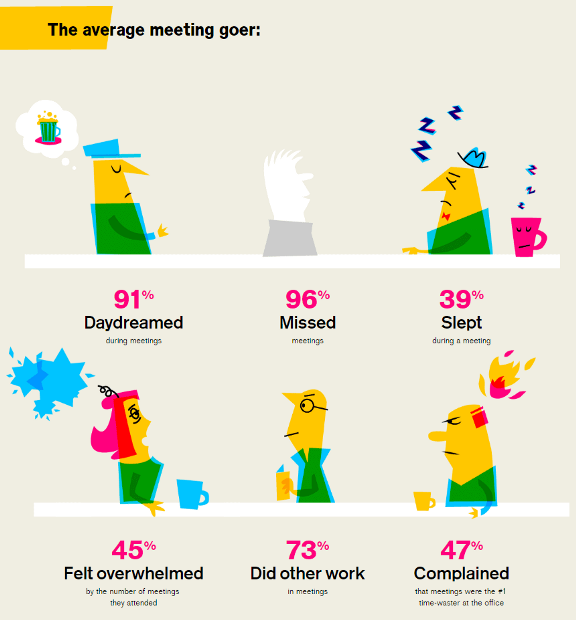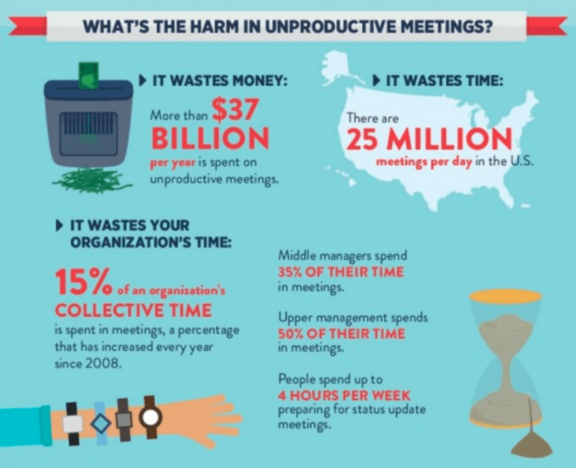Did you know that in most cases, when employees open up a meeting invite they think to themselves: “Oh no, not a meeting again!”
In this day and age, meetings have become a cornerstone of successful business development. They encourage open communication among team members, especially in those teams that are dispersed globally. Employees, during a meeting, have the chance to state their opinions, share an idea, exchange information, and build interpersonal trust.
However, according to a recent survey from the Harvard Business Review, 71% of senior managers said meetings are unproductive and inefficient. With so many types of meetings, managers are faced with the challenge to figure out which are productive for the team and which aren’t.
Although it varies from team to team, these are the 5 most effective meetings that can maximize employee productivity and engagement.
Onboarding Meetings
Onboarding a new employee is not just signing a contract and meeting the team. These employees will become part of your company culture, will collaborate with other employees, and will represent your company. For this reason, holding onboarding meetings to welcome each new employee is always a good decision.
During the first week, hold a thorough onboarding meeting where you’ll:
- Discuss the company culture
- Explain to them their role.
- Let them introduce themselves
- If they’re new to town, give them suggestions of good places to eat and visit.
- Discuss your company’s code of conduct.
- Discuss the following projects.
- Explain how they fit in the bigger picture.
- Explain to them what they should do in their first few weeks and months.
A great idea would be to create an employee onboarding template or checklist with all of this information, then simply copy and personalize it for each new person. You can also create a “new hire” channel on Slack that’ll be a designated space for introductions, discussions of benefits, and sharing information that helps new employees get started.

Brainstorming Meetings
Do you want to move a team forward? Do you want to manage a successful organization? Hold brainstorming meetings. They are a type of highly effective meetings that can help teams be creative together, solve problems, or think of different solutions to a problem. The brainstorming topics can be diverse and can include product vision, organizational structure, project management techniques, etc.
Here are some tips for running a productive meeting:
- Start by addressing the topic, issues, and goals that the team is focusing on.
- Go in a circle, discussing everyone’s ideas.
- Discuss the ideas thoroughly.
- Compare the ideas directly against the goals.
- Allow the group to pick the best idea.
- End the interview with an idea that can be actioned and tested.
To hold a successful brainstorming meeting you’ll need a lot of work and preparation. The meeting has to be interesting, fun, and engaging to avoid having the members daydreaming. If done right, it can transform your organization, resulting in an improved product, and encourage innovation among employees.
Kick-Off Meetings
Kick-off meetings are the first meeting that is held once a project begins. Once the client and the development company agree to work together, this type of effective meeting follows. It comes after all the initial discussions and negotiations and it can influence the outcome of the project immensely.
A successful kick-off meeting can result in the team embracing the project’s objectives, getting inspiration, finding motivation, and planning the project (time, cost, scope). To make sure that each employee completely understands the project, that all of the stakeholders understand the details, you may need to hold multiple kick-off meetings to ensure all goals are achieved and set.
There are a few essential topics you need to cover, including:
- Identify the team members and their separate roles on the project.
- Identify the main objectives and intended outcomes.
- Establish project requirements.
- Discuss any issues that arose while talking about the specifications of the project.
- Establish an approximate schedule for project completion.
Feedback Meetings
Giving feedback is more than just a pat on the back. There is a proper way of providing feedback, resulting in fruitful results like increased employee engagement. One way is by holding regular feedback meetings if you want your team to really learn from their experience.
Whether it’s a startup or a huge corporation, feedback is crucial to improving performance. Reports show that when feedback is given between managers and employees, engagement rates jump to 79%. Holding effective feedback meetings is an opportunity for team members to come together and discuss what went well, what didn’t go so well, and what can be changed.
There are three types of feedback you can give to your employees during a meeting:
- Positive constructive: “You had great ideas at the meeting earlier. Hope you’ll have plenty more in the future.”
- Negative constructive: “You had good ideas at the meeting earlier. However, I feel like you still need some guidance. Is there anything we can do to help?”
- Negative destructive: The ideas you had during the meeting were awful. No one was interested in what you had to say. Maybe you shouldn’t talk next time.”
While positive constructive and negative constructive feedback is a great way to show your employees that you’re invested in them and want to see them grow, the negative destructive feedback can only result in disengaged employees and an increased turnover.

All-hands Meetings
All-hands meetings are another type of effective meetings that many companies hold at least four times a year. They are an awesome opportunity to meet everyone that’s part of the company, from interns to VPs. Everyone can ask questions, voice concerns, and present their teams’ successes. If you want people who don’t work closely together to feel connected on a personal and professional level, this is the meeting to do so.
During an all-hands meeting, the entire company comes together and shares updates, asks questions, and gets to know senior leadership. The goal is for everyone to receive the same information and messages. This is also a great opportunity to discuss thorny issues and to convey difficult news. And to have fun as well!
Effective Meetings Can Save You Time
Many people, when they hear the word “meeting”, think about a bunch of people sitting around a table and discussing ideas. Today, more and more companies opt for virtual meetings. Why? Because they take less time and energy to set up and is also easier for remote employees and workers who work from other offices to be present. Apart from being inclusive and accessible to all members, virtual meetings also allow the entire meeting to be recorded. This can be helpful as those who can’t make it to the meeting will have the chance to catch up and stay on track.
To conclude, whether it’s in-person or virtual, the most effective meetings that every company needs are:
- Onboarding meeting
- Brainstorming meetings
- Kick-off meetings
- Feedback meetings
- All-hands meetings
What are other types of meetings your team loves attending? Share them in the comments below!









